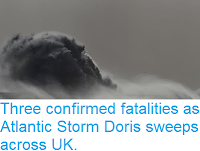Six people have died in Germany, Poland and the Czech Republic as Storm Herwart swept across northern Europe on Sunday 29 October 2017. Four people were killed by falling trees in Poland and the Czech Republic, while three people have drowned in Germany, a 63-year-old man in the state of Lower Saxony who was caught by a storm surge and two people in Mecklenburg-Vorpommern whose boat capsized; a third passenger on the same boat is still missing. Also in Lower Saxony a 225 m freighter, the Glory Amsterdam, was run aground on the island of Langeoog in the East Frisian Islands, while two people were injured by falling roof tiles and scaffolding in Berlin, and four further people were injured in incidents elsewhere in Germany. The storm caused power outages across parts of Germany, the Czech Republic and Austria.
Flooding in Hamburg caused by Storm Herwart. DPA.
Ocean storms form due to heating of air over the sea, usually in tropical zones, though Herwart formed off the coast of southern Scandinavia. As the air is heated the the air pressure drops and the air rises, causing new air to rush in from outside the forming storm zone. If this zone is sufficiently large, then it will be influenced by the Coriolis Effect, which loosely speaking means the winds closer to the equator will be faster than those further away, causing the storm to rotate, clockwise in the northern hemisphere and anticlockwise in the southern hemisphere.
Damaged scaffolding in Berlin following Storm Herwart. DPA.
Despite the obvious danger of winds of this speed, which can physically
blow people, and other large objects, away as well as damaging buildings
and uprooting trees, the real danger from these storms comes from the
flooding they bring. Each drop millibar drop in air-pressure leads to an
approximate 1 cm rise in sea level, with big tropical storms capable of
causing a storm surge of several meters. This is always accompanied by
heavy rainfall, since warm air over the ocean leads to evaporation of
sea water, which is then carried with the storm. These combined often
lead to catastrophic flooding in areas hit by ocean storms.
See also...
Follow Sciency Thoughts on Facebook.








